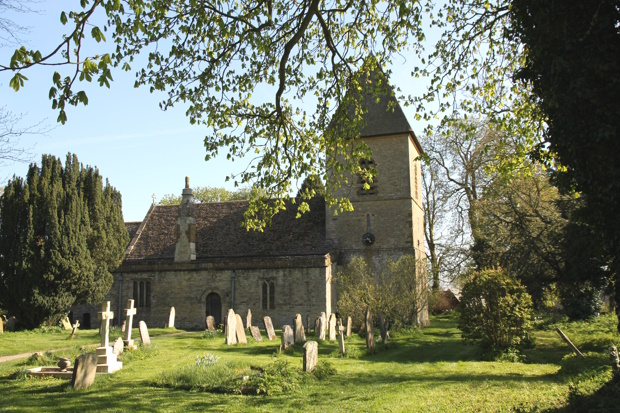


























St. Olave's Church, Fritwell
St. Olave's Church in Fritwell is a stone building comprising chancel, nave, north and south aisles, western tower, and south porch. The Romanesque chancel arch, now inserted in the north wall of the chancel, the nave arcades, and the north and south doorways are the oldest parts of the church. The north door has cable mouldings on the dripstone terminating in two grotesque animal heads, and the south door is surmounted by a tympanum with a carving representing two monsters on either side of a tree. The chancel was rebuilt early in the 13th century, when the south aisle and tower were added. Some lancet windows remain in the chancel and south aisle. The north aisle was added early in the 14th century. In the 15th century a good deal of work was done to the building: the former clerestory with its square-headed windows was probably built then; some new windows were inserted in the aisles; and a battlemented top story was added to the tower. Work costing £22 was done to the church in 1694, and in 1718 Rawlinson described the building as 'very neat' and 'in good repair'. inor repairs were carried out in the second half of the 18th century and in the early 19th century. But a period of neglect followed, and in 1852 and 1853 the roofs of the chancel and the nave were said to be in a bad condition. In 1854 the curate thought the church 'in the most disgraceful possible condition and unsafe to minister in'. The lay rector promised to repair the chancel. In 1864, largely owing to the vicar, Samuel Yorke, a drastic restoration costing £2,000 was undertaken (architect G. E. Street). As the medieval tower was cracked, it was rebuilt with a pyramidal roof covered with shingles; both chancel walls, the north wall of the nave, and the south porch were also rebuilt; the clerestory was removed and replaced by a new high-pitched roof; a new chancel arch was built, and the original one, being considered too narrow, was moved to its present position; a new east window was inserted and the former square-headed one was moved to the north aisle; the western gallery was taken down; new seating was put in, in imitation of the seats found during restoration work; and heating was installed. The font is octagonal, with carving in low relief. There is a 13th-century holy-water stoup in the chancel and a medieval oak bench in the nave. The organ loft has Jacobean panels taken from an old pew. The woodwork of a finely carved pew, erected by Edward Yorke, was taken to the manor-house during the restoration of 1864. Part of the rood loft was still in position in 1823. There is a brass inscription to William Hickock (d. 1638). Inscriptions to Richard Hickock (d. 1708/9), William Vaughan, vicar (d. 1740), James Hakewill, vicar (d. 1798), two daughters of Laurence Lord (early 18th cent.), and Mary Court (d. 1824), a descendant of the Hickocks, have disappeared. In 1552 the plate consisted of a chalice, censer, and brass 'holywater stooke' and candlesticks. By 1593 there were a communion cup, a pewter ewer and dish, and a brass pan. In 1722 the plate was still pewter, except for a silver cup which had been given by Mary Barker. This was probably the silver chalice, dated 1637, the only pre-19th-century plate which the church had in 1955. In 1955 there were four bells instead of the three bells of 1552. The second and tenor were made in 1612 and 1618, the third, recast in 1665, may be of 16th-century or earlier date, and the sanctus bell probably dates from the 16th century. The registers begin in 1558. The churchwardens' accounts, beginning in 1568, from which Blomfield quotes, have disappeared. In the churchyard in 1955 was the remains of a cross, restored in 1913. Historical information about St Olave's Church is provided by 'Parishes: Fritwell', in A History of the County of Oxford: Volume 6, ed. Mary D Lobel (London, 1959), pp. 134-146. British History Online http://www.british-history.ac.uk/vch/oxon/vol6/pp134-146 [accessed 31 January 2023]. St. Olave's Church is a Grade II* listed building. For more information about the listing see Church of St Olave , Fritwell - 1046892 | Historic England. For more information about St. Olave's Church see Parishes: Fritwell | British History Online (british-history.ac.uk) |

